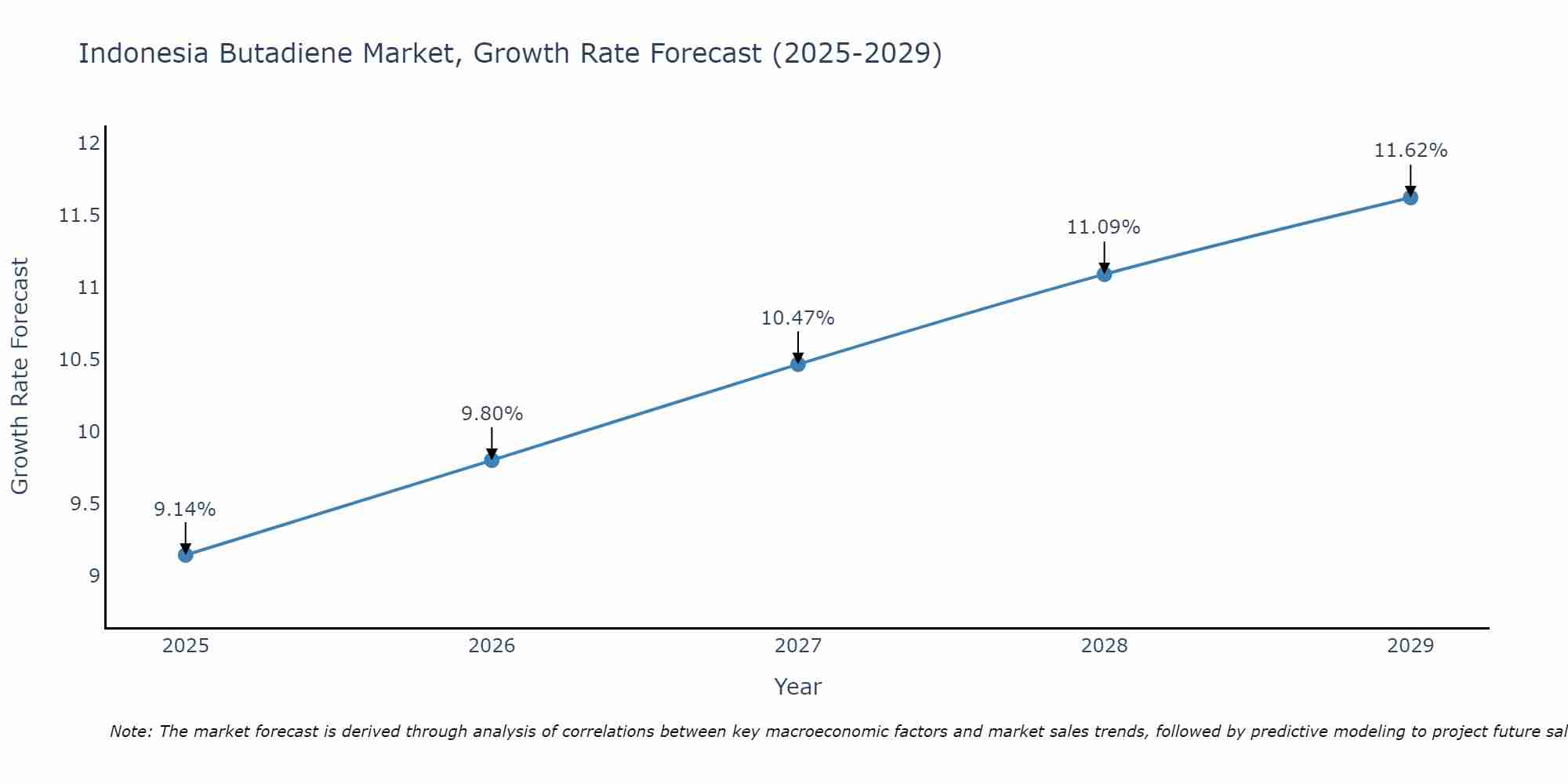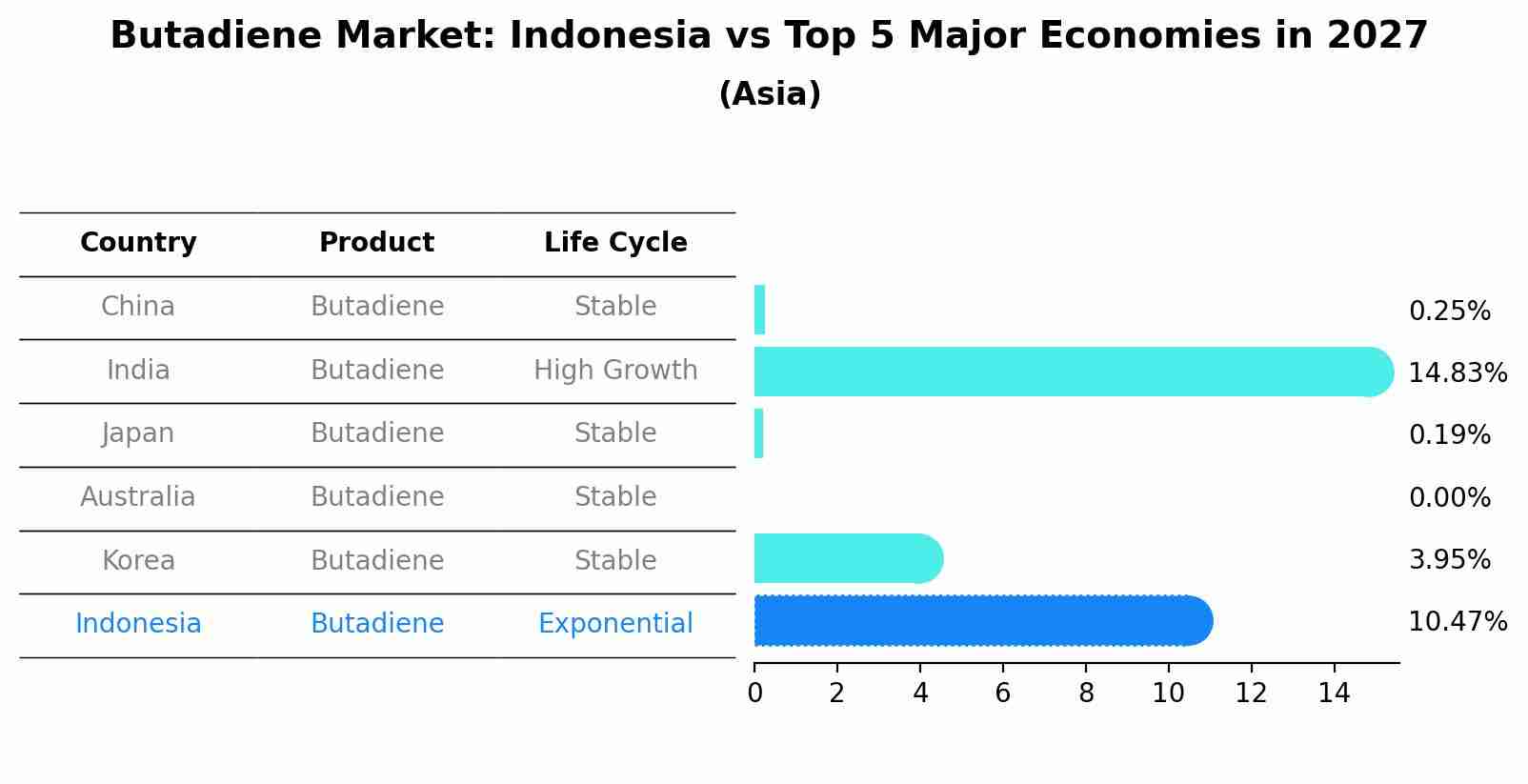Indonesia Butadiene Market (2025-2031) Outlook | Revenue, Value, Share, Industry, Trends, Growth, Companies, Size, Analysis & Forecast
| Product Code: ETC109787 | Publication Date: Jul 2023 | Updated Date: Apr 2025 | Product Type: Report | |
| Publisher: 6Wresearch | No. of Pages: 70 | No. of Figures: 35 | No. of Tables: 5 | |
Indonesia Butadiene Market Size Growth Rate
The Indonesia Butadiene Market is likely to experience consistent growth rate gains over the period 2025 to 2029. The growth rate starts at 9.14% in 2025 and reaches 11.62% by 2029.

Butadiene Market: Indonesia vs Top 5 Major Economies in 2027 (Asia)
By 2027, Indonesia's Butadiene market is forecasted to achieve a high growth rate of 10.47%, with China leading the Asia region, followed by India, Japan, Australia and South Korea.

Indonesia Butadiene Market Synopsis
Indonesia is the largest producer and consumer of butadiene in Southeast Asia. In 2025, it was estimated to have a market size of USD 9.1 billion. The production and consumption of butadiene are dominated by rubber processing companies such as Petrokimia Gresik and Asahimas Chemicals Sdn Bhd, who mainly use petrochemical feedstock like ethylene or propylene derived from crude oil for its production process in Indonesia. The country also has major export markets such as China, United States, Thailand, Singapore and India for Butadiene based products.
Market Trends
The growth of the Indonesia Butadiene Market has been slower than expected due to weak demand from the automotive industry caused by weaker economic conditions associated with COVID-19 pandemic which has impacted investments across all sectors including petrochemicals/rubber industries significantly resulting into supply chain disruptions. Additionally, rising competition among suppliers coupled with increasing cost pressures on manufacturers will further affect prices negatively over the forecast period (2025 - 2025). However, there is some potential optimism around an increase in downstream demand from other industries such as packaging materials because of growing ecommerce activities during pandemic times especially in food industry driving up sales volumes for Polyethylene terephthalate (PET) bottles & jerry cans manufactured using butadiene derivatives.
Market Drivers
The Indonesia butadiene market is driven by the growing demand for rubber products in the automotive industry, which uses butadiene as a main raw material. This has resulted in an increase in demand for butadiene from various end-use industries such as rubber and plastics. Another key factor driving growth of the Indonesia butadiene market is increasing prices due to rising international crude oil prices and limited availability of supply from local producers, resulting in higher cost inputs for downstream processing units. In addition, government initiatives towards developing infrastructure and encouraging foreign investments are contributing significantly to expansion of the domestic manufacturing sector, leading to increased consumption of industrial chemicals like butadiene across a wide range of applications such as tires and other rubber products.
COVID-19 Impact on the Market
The COVID-19 pandemic has had a major impact on the Butadiene market in Indonesia. Demand for butadiene has declined significantly, resulting in lower prices and decreased production levels due to reduced domestic consumption and weak export demand. The lockdown measures imposed by the government have further hampered operations of major players in the industry.
Challenges of the Market
The major challenge facing the Indonesia butadiene market is its dependence on imported raw materials, which affects both production costs as well as availability of supply. Additionally, low consumer spending power due to economic downturns also weighs heavily on local demand for Butadiene products. Lastly, stringent environmental regulations governing emissions from plants are also causing problems for manufacturers looking to expand their capacity or enter into new markets.
Industry Key Players
The key players operating in the Indonesia Butadiene Market are PT Sari Husada, PT Petrokimia Gresik, Pertamina Refinery Unit IV Cilacap (RU IV), and PT Chandra Asri Petrochemical Tbk (CAP). These companies account for around 70% of total domestic production capacity of butadiene in Indonesia.
Key Highlights of the Report:
- Indonesia Butadiene Market Outlook
- Market Size of Indonesia Butadiene Market, 2024
- Forecast of Indonesia Butadiene Market, 2031
- Historical Data and Forecast of Indonesia Butadiene Revenues & Volume for the Period 2021-2031
- Indonesia Butadiene Market Trend Evolution
- Indonesia Butadiene Market Drivers and Challenges
- Indonesia Butadiene Price Trends
- Indonesia Butadiene Porter's Five Forces
- Indonesia Butadiene Industry Life Cycle
- Historical Data and Forecast of Indonesia Butadiene Market Revenues & Volume By Application Type for the Period 2021-2031
- Historical Data and Forecast of Indonesia Butadiene Market Revenues & Volume By Butadiene Rubber for the Period 2021-2031
- Historical Data and Forecast of Indonesia Butadiene Market Revenues & Volume By Styrene Butadiene Rubber for the Period 2021-2031
- Historical Data and Forecast of Indonesia Butadiene Market Revenues & Volume By Acrylonitrile Butadiene Rubber for the Period 2021-2031
- Historical Data and Forecast of Indonesia Butadiene Market Revenues & Volume By Nitrile Butadiene Rubber for the Period 2021-2031
- Historical Data and Forecast of Indonesia Butadiene Market Revenues & Volume By Styrene Butadiene Latex for the Period 2021-2031
- Historical Data and Forecast of Indonesia Butadiene Market Revenues & Volume By Hexamethylenediamine for the Period 2021-2031
- Historical Data and Forecast of Indonesia Butadiene Market Revenues & Volume By Others for the Period 2021-2031
- Historical Data and Forecast of Indonesia Butadiene Market Revenues & Volume By End Use Type for the Period 2021-2031
- Historical Data and Forecast of Indonesia Butadiene Market Revenues & Volume By Plastic and Polymer for the Period 2021-2031
- Historical Data and Forecast of Indonesia Butadiene Market Revenues & Volume By Tire and Rubber for the Period 2021-2031
- Historical Data and Forecast of Indonesia Butadiene Market Revenues & Volume By Automobile for the Period 2021-2031
- Historical Data and Forecast of Indonesia Butadiene Market Revenues & Volume By Chemical for the Period 2021-2031
- Historical Data and Forecast of Indonesia Butadiene Market Revenues & Volume By Others for the Period 2021-2031
- Indonesia Butadiene Import Export Trade Statistics
- Market Opportunity Assessment By Application Type
- Market Opportunity Assessment By End Use Type
- Indonesia Butadiene Top Companies Market Share
- Indonesia Butadiene Competitive Benchmarking By Technical and Operational Parameters
- Indonesia Butadiene Company Profiles
- Indonesia Butadiene Key Strategic Recommendations
Frequently Asked Questions About the Market Study (FAQs):
- Single User License$ 1,995
- Department License$ 2,400
- Site License$ 3,120
- Global License$ 3,795
Search
Related Reports
- Uganda Precast and Aggregate Market (2025-2031) | Strategy, Consumer Insights, Analysis, Investment Trends, Opportunities, Growth, Size, Share, Industry, Revenue, Segments, Value, Segmentation, Supply, Forecast, Restraints, Outlook, Competition, Drivers, Trends, Demand, Pricing Analysis, Competitive, Strategic Insights, Companies, Challenges
- Australia IT Asset Disposal Market (2025-2031) | Strategy, Consumer Insights, Analysis, Investment Trends, Opportunities, Growth, Size, Share, Industry, Revenue, Segments, Value, Segmentation, Supply, Forecast, Restraints, Outlook, Competition, Drivers, Trends, Demand, Pricing Analysis, Competitive, Strategic Insights, Companies, Challenges
- UAE Building Thermal Insulation Market Outlook (2025-2031) | Revenue, Companies, Share, Trends, Growth, Size, Forecast, Industry, Analysis & Value
- Portugal Electronic Document Management Market (2025-2031) | Strategy, Consumer Insights, Analysis, Investment Trends, Opportunities, Growth, Size, Share, Industry, Revenue, Segments, Value, Segmentation, Supply, Forecast, Restraints, Outlook, Competition, Drivers, Trends, Demand, Pricing Analysis, Competitive, Strategic Insights, Companies, Challenges
- France Electronic Document Management Market (2025-2031) | Strategy, Consumer Insights, Analysis, Investment Trends, Opportunities, Growth, Size, Share, Industry, Revenue, Segments, Value, Segmentation, Supply, Forecast, Restraints, Outlook, Competition, Drivers, Trends, Demand, Pricing Analysis, Competitive, Strategic Insights, Companies, Challenges
- Portugal Occupational Health & Safety Services Market (2025-2031) | Strategy, Consumer Insights, Analysis, Investment Trends, Opportunities, Growth, Size, Share, Industry, Revenue, Segments, Value, Segmentation, Supply, Forecast, Restraints, Outlook, Competition, Drivers, Trends, Demand, Pricing Analysis, Competitive, Strategic Insights, Companies, Challenges
- Netherlands Occupational Health and Safety Services Market (2025-2031) | Strategy, Consumer Insights, Analysis, Investment Trends, Opportunities, Growth, Size, Share, Industry, Revenue, Segments, Value, Segmentation, Supply, Forecast, Restraints, Outlook, Competition, Drivers, Trends, Demand, Pricing Analysis, Competitive, Strategic Insights, Companies, Challenges
- Belgium and Luxembourg Facility Management Market (2025-2031) | Strategy, Consumer Insights, Analysis, Investment Trends, Opportunities, Growth, Size, Share, Industry, Revenue, Segments, Value, Segmentation, Supply, Forecast, Restraints, Outlook, Competition, Drivers, Trends, Demand, Pricing Analysis, Competitive, Strategic Insights, Companies, Challenges
- Russia Women Intimate Apparel Market (2025-2031) | Strategy, Consumer Insights, Analysis, Investment Trends, Opportunities, Growth, Size, Share, Industry, Revenue, Segments, Value, Segmentation, Supply, Forecast, Restraints, Outlook, Competition, Drivers, Trends, Demand, Pricing Analysis, Competitive, Strategic Insights, Companies, Challenges
- Africa Chocolate Market (2025-2031) | Size, Share, Trends, Growth, Revenue, Analysis, Forecast, industry & Outlook
Industry Events and Analyst Meet
Our Clients
Whitepaper
- Middle East & Africa Commercial Security Market Click here to view more.
- Middle East & Africa Fire Safety Systems & Equipment Market Click here to view more.
- GCC Drone Market Click here to view more.
- Middle East Lighting Fixture Market Click here to view more.
- GCC Physical & Perimeter Security Market Click here to view more.
6WResearch In News
- Doha a strategic location for EV manufacturing hub: IPA Qatar
- Demand for luxury TVs surging in the GCC, says Samsung
- Empowering Growth: The Thriving Journey of Bangladesh’s Cable Industry
- Demand for luxury TVs surging in the GCC, says Samsung
- Video call with a traditional healer? Once unthinkable, it’s now common in South Africa
- Intelligent Buildings To Smooth GCC’s Path To Net Zero













